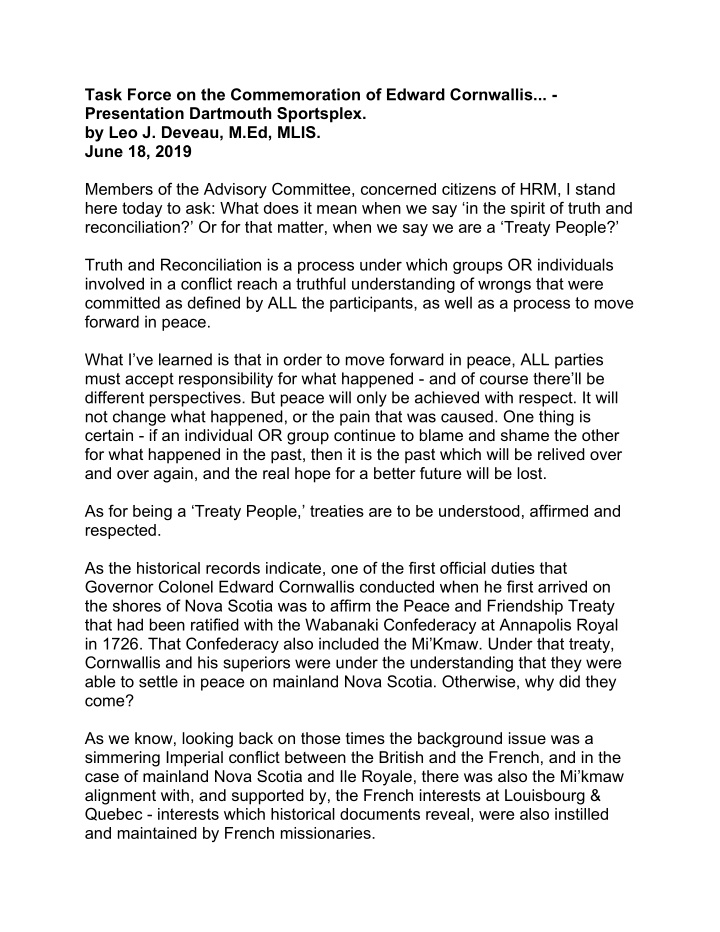



Task Force on the Commemoration of Edward Cornwallis... - Presentation Dartmouth Sportsplex. by Leo J. Deveau, M.Ed, MLIS. June 18, 2019 Members of the Advisory Committee, concerned citizens of HRM, I stand here today to ask: What does it mean when we say ‘in the spirit of truth and reconciliation?’ Or for that matter, when we say we are a ‘Treaty People?’ Truth and Reconciliation is a process under which groups OR individuals involved in a conflict reach a truthful understanding of wrongs that were committed as defined by ALL the participants, as well as a process to move forward in peace. What I’ve learned is that in order to move forward in peace, ALL parties must accept responsibility for what happened - and of course there’ll be different perspectives. But peace will only be achieved with respect. It will not change what happened, or the pain that was caused. One thing is certain - if an individual OR group continue to blame and shame the other for what happened in the past, then it is the past which will be relived over and over again, and the real hope for a better future will be lost. As for being a ‘Treaty People,’ treaties are to be understood, affirmed and respected. As the historical records indicate, one of the first official duties that Governor Colonel Edward Cornwallis conducted when he first arrived on the shores of Nova Scotia was to affirm the Peace and Friendship Treaty that had been ratified with the Wabanaki Confederacy at Annapolis Royal in 1726. That Confederacy also included the Mi’Kmaw. Under that treaty, Cornwallis and his superiors were under the understanding that they were able to settle in peace on mainland Nova Scotia. Otherwise, why did they come? As we know, looking back on those times the background issue was a simmering Imperial conflict between the British and the French, and in the case of mainland Nova Scotia and Ile Royale, there was also the Mi’kmaw alignment with, and supported by, the French interests at Louisbourg & Quebec - interests which historical documents reveal, were also instilled and maintained by French missionaries.
2 As a military officer and a newly appointed Governor, Cornwallis’s first allegiance was to the mission of establishing a British settlement, as well ensuring the safety and security of the settlers. Once the settlement was attacked (and it was attacked numerous times), such actions became in his eyes, a breach of the treaty that he had affirmed earlier. In fact, his later correspondence to his superiors indicates this understanding. Ironically the Mi’Kmaq also thought it was a breach of the treaty, but not in the same way. In essence, Cornwallis and the Mi’Kmaq were caught up in larger events happening around them. Today Cornwallis has unjustly become a lightning rod for all the grievances the Indigenous have had since their first contact with European settlers. Oddly, in the context of Cornwallis, what is not acknowledged is also the courage and resistance that the Mi’kmaq people undertook against the British during those times of conflict. Cornwallis on the other hand, like all British soldiers of those times, was trained in the tactics of 18th century weaponry, defence and warfare. From 1749, it would take fourteen years till the Treaty of Paris (1763) when peace was finally declared with the French, and as a consequence with the Mi’Kmaw. In summary, Edward Cornwallis was a man who was assigned a mission and carried it out with the knowledge, experience and resources he had at the time. In his three-year tenure, 270 years ago this month (June), he planted the British settlement and established the name of Halifax which we acknowledge and accept today - in addition we also recognize that Halifax exists on the ancestral lands of the Mi’kmaw – with the harbour area named Ki’jipuktuk. Whatever becomes of Cornwallis’s statue will not change any of this history OR what that history reveals - namely that Edward Cornwallis was in fact a Treaty person who had affirmed what he thought was an understanding
3 with the Wabanaki, and as a consequence, the Mi’Kmaw. The Cornwallis statue will not find another public space because we know where the majority of Task Force members wish it to be, namely in a museum - hidden from public view - other than to those who choose to visit. However, a much more constructive solution would be to have the statue be reinstalled on the military grounds of the historic Royal Artillery Park on the site of the former Cornwallis Fort, one of five blockhouse forts that were constructed around the Halifax settlement to protect it from attacks. In this way the statue would remain publicly visible as an important reminder of our city’s long and deep history. Thank-you for allowing me time to share these thoughts.
Recommend
More recommend